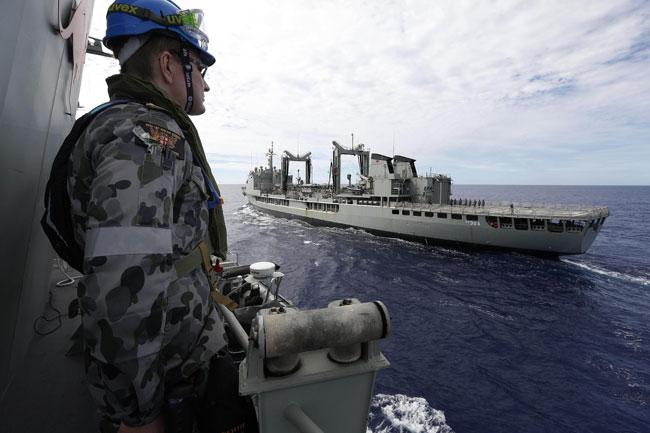A fresh underwater acoustic signal possibly from the crashed Malaysian jet was today detected, fuelling hopes of an early breakthrough in the arduous hunt for the plane as searchers zeroed in on a smaller area in the Indian Ocean
Perth: A fresh underwater acoustic signal possibly from the crashed Malaysian jet was today detected, fuelling hopes of an early breakthrough in the arduous hunt for the plane as searchers zeroed in on a smaller area in the Indian Ocean.
ADVERTISEMENT
On the 33rd day of the search for the Malaysia Airlines Flight MH370 - that vanished mysteriously on March 8 with 239 people on board - an Australian naval aircraft picked up an underwater signal in the same area where searchers in ships previously detected sounds consistent with a plane's black box.
 This handout photo by Australian Defence shows a Maritime Warfare Officer, watching HMAS Success as HMAS Perth approaches for a replenishment at sea while searching for missing Malaysia Airlines flight MH370 in the southern Indian Ocean. Pic/AFP
This handout photo by Australian Defence shows a Maritime Warfare Officer, watching HMAS Success as HMAS Perth approaches for a replenishment at sea while searching for missing Malaysia Airlines flight MH370 in the southern Indian Ocean. Pic/AFP
While conducting an acoustic search this afternoon, an RAAF AP-3C Orion aircraft detected a possible signal in the vicinity of the Australian Defence Vessel Ocean Shield, said Angus Houston, head of the Perth-based Joint Agency Coordination Centre (JACC) which is leading the search.
"The acoustic data will require further analysis overnight but shows potential of being from a man-made source," Houston said.
Finding the black box is crucial to know why the Beijing- bound Boeing 777-200 with 239 people, including five Indians, veered off from its route after taking off from Kuala Lumpur.
The batteries of the black box flight recorders have a life of about 30 days, meaning they either might have been or are on the verge of being drained out.
Stored in a plane's tail, they are designed to begin sending off distinct, high-pitched pings or signals as soon as they come in contact with water.
The Ocean Shield, bearing a special US Navy "towed pinger locator", had picked up two fresh signals on Tuesday that matched a pair of signals detected over the weekend consistent with a plane's black box.
Today, Australian Maritime Safety Authority (AMSA) narrowed down drastically the search area to about 57,923 sq km from yesterday's 75,000 sq km, the smallest yet in the month-long hunt. The centre of the search area lies approximately 2,280 km north west of Perth.
Up to 10 military aircraft, four civil aircraft and 13 ships were assist in today's search for the plane that authorities believe crashed in the Indian Ocean. The three vessels - the Ocean Shield to the north, and the British HMS Echo and Chinese Haixun 01 to the south -- were focussing underwater.
The development came a day after Houston expressed the searchers are approaching the "final resting place" of the ill-fated plane. "I'm now optimistic. We'll find the aircraft or what's left of the aircraft in the not too distant future.
Hopefully in a matter of days, we will be able to find something on the bottom that might confirm that this is the last resting place of MH370," he said yesterday. Aircraft and ships reported spotting a large number of objects during yesterday's search, but only a small number were able to be recovered.
None of the recovered items were believed to be associated with the Boeing 777-200. Houston had said there will be no confirmation of a link to the plane until wreckage is found.
In another major development yesterday, Australian authorities analysed the signals picked up on Saturday and determined that they were not natural occurrences, but likely came from specific electronic equipment. Some marine life make similar sounds.
All the earlier four "pings" were recorded within approximately 27 kilometres of one another. The mystery of the missing plane has continued to baffle aviation and security authorities who have so far failed to trace the aircraft despite deploying hi-tech radar and other gadgets.
Investigators still do not know why the airliner strayed so far off course, after disappearing over the South China Sea between Malaysia and Vietnam.
The backgrounds of both passengers and crew have been scrutinised as officials considered hijacking, sabotage, pilot action or mechanical failure as possible causes.
So far, there is no official explanation for what might have happened.
 Subscribe today by clicking the link and stay updated with the latest news!" Click here!
Subscribe today by clicking the link and stay updated with the latest news!" Click here!







